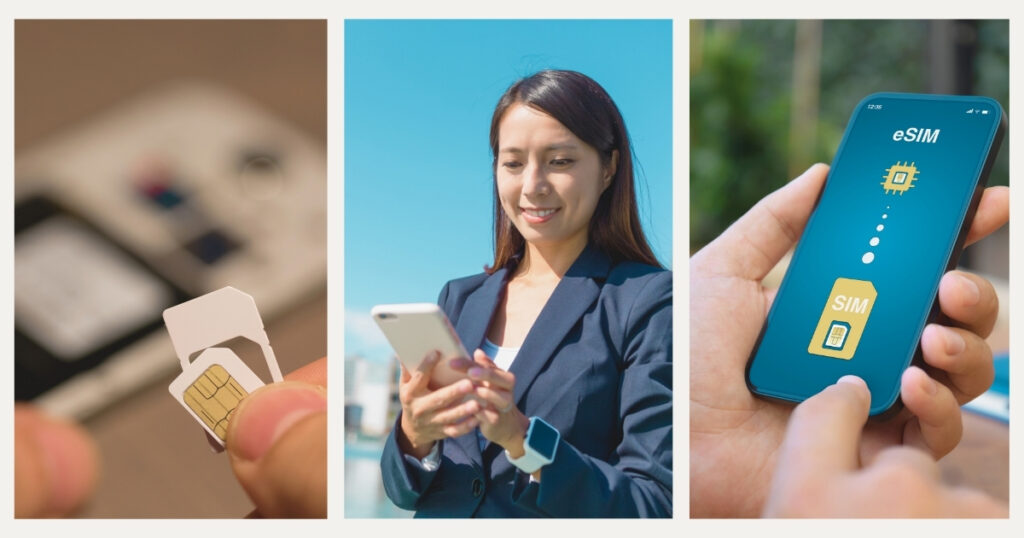Reliable internet connectivity is the lifeline of every digital nomad. Whether you’re attending virtual meetings from a Bali beachfront or sending deliverables from a Mexico City café, staying connected isn’t just convenient—it’s essential for your livelihood.
Finding the right prepaid SIM card solution can be the difference between seamless productivity and frustrating connectivity failures. With varying data plans, network coverage, and pricing structures across countries, navigating the global mobile connectivity landscape requires strategic preparation.
In this comprehensive guide, Nomada explains everything digital nomads need to know about prepaid SIM cards—from choosing the right option for your specific location to maximizing data plans for optimal value. Let’s keep you connected wherever your nomadic journey takes you.
Understanding prepaid SIM card basics for global mobility

Before diving into specific strategies, it’s essential to understand what makes prepaid SIM cards particularly suitable for the digital nomad lifestyle. These small, switchable chips offer flexibility and cost control that traditional phone plans often can’t match for international travelers.
How prepaid SIM cards work for international travelers
A prepaid SIM card contains a unique identifier that connects your device to a local mobile network. Unlike contract plans, prepaid options let you pay only for the data, minutes, and texts you need upfront—with no surprising bills or long-term commitments. This pay-as-you-go approach perfectly matches the unpredictable nature of nomadic living.
Most prepaid SIM cards are country-specific, operating on local networks to provide optimal speeds and reliability. They typically come with a local phone number and varying data allowances, from as little as 1GB to “unlimited” plans (usually with fair usage policies). Activation is usually straightforward, though some countries require passport registration for security purposes.
🌟 Pro tip: before purchasing a local prepaid SIM card, check if your phone is unlocked. Carrier-locked devices won’t accept SIM cards from other providers. Contact your home provider before traveling to request an unlock if needed.
Prepaid SIM cards vs. international roaming
While your home network might offer international roaming, these services typically come with significant limitations. Roaming data is notoriously expensive, often charging $10-15 per day or imposing steep per-megabyte rates. Even “unlimited” international packages usually throttle speeds severely after modest usage.
Prepaid SIM cards offer substantially better value, with local rates often providing 5-10 times more data for the same price as a single day of roaming. They also deliver faster speeds by connecting directly to local networks rather than routing data internationally. For stays longer than a few days, the savings and performance benefits make prepaid SIMs the clear choice for connectivity-dependent digital nomads.
💡 Did you know? The average digital nomad can save over $300 per month by using local prepaid SIM cards instead of international roaming from their home carrier, while enjoying significantly faster connection speeds and more reliable service.
Choosing the right prepaid SIM card for your destination

Not all prepaid SIM cards are created equal, and the best option varies significantly depending on your destination country, length of stay, and connectivity needs. Research before arrival can save considerable time and frustration.
Researching network coverage and reliability
Network quality varies dramatically between carriers, even within the same country. While urban centers typically offer excellent coverage from multiple providers, rural areas or islands might be serviced by only one reliable carrier. Before purchasing, research which network offers the strongest coverage in your specific destinations.
Online resources like OpenSignal and Speedtest provide crowdsourced data on network performance across regions. Digital nomad forums and Facebook groups often contain location-specific recommendations based on real experiences. Prioritize reliable connectivity over slightly cheaper rates—the productivity loss from poor connections almost always outweighs modest savings.
Data package options and limitations
Most prepaid SIM providers offer various data packages with validity periods ranging from days to months. Consider your typical data consumption patterns when selecting a plan. Video calls consume approximately 600MB-1.5GB per hour, while standard web browsing and email might use only 5-10MB per hour.
Be aware of hidden limitations within data packages. Some providers advertise “unlimited” data but implement severe speed throttling after reaching certain thresholds. Others might restrict tethering or hotspot capabilities, which can be crucial for nomads working on multiple devices. Always read the fine print, particularly regarding fair usage policies.
🌟 Pro tip: purchase a prepaid SIM card with slightly more data than you think you’ll need. Running out mid-month can disrupt your workflow, and topping up often costs more per gigabyte than buying a larger package initially.
Purchasing and activation process
Obtaining a prepaid SIM card varies in complexity depending on your destination. In some countries like Thailand or Malaysia, you can purchase and activate SIMs at airports, convenience stores, or carrier shops with minimal paperwork. Others, like Germany or Japan, require formal identification and address registration, making the process more time-consuming.
Plan where you’ll purchase your SIM card before arrival. Airport kiosks offer convenience but often charge premiums of 20-50% over downtown prices. In countries with complex registration requirements, official carrier stores typically provide English-speaking assistance and proper setup, justifying any slight premium over resellers.
Advanced connectivity strategies for digital nomads

Beyond basic prepaid SIM cards, digital nomads can implement several advanced strategies to ensure consistent connectivity regardless of location or circumstances. As remote work becomes increasingly mainstream, connectivity solutions have evolved to meet the specific needs of location-independent professionals. Understanding these advanced options gives you a significant advantage in maintaining productivity while embracing the freedom of borderless work.
Dual SIM and eSIM solutions
Modern smartphones increasingly offer dual SIM capabilities, allowing you to maintain two active connections simultaneously. This provides valuable redundancy—if one network experiences issues, you can immediately switch to the alternate. Dual SIMs also let you keep your home number active for important calls while using a local number for data and local communications.
The emerging eSIM technology takes this flexibility even further. A reliable travel eSIM from Holafly allows you to digitally activate local connectivity without physically swapping SIM cards. This provides immediate connectivity upon landing and enables you to maintain multiple profiles for different countries without juggling physical cards.
Creating reliable backup connectivity options
Depending on a single connection method creates vulnerability in your work setup. Smart digital nomads develop layered connectivity strategies that include:
Key considerations for building a resilient connectivity system:
- Maintain separate prepaid SIM cards from different network providers
- Carry a portable WiFi hotspot with its own data plan for critical periods
- Research coworking spaces with reliable internet for important meetings
- Download essential work materials for offline access when possible
- Keep a list of reliable cafés and public spaces with quality WiFi
- Consider satellite internet options for extremely remote locations
🌟 Pro tip: create a “connectivity emergency kit” with all your SIM cards, a SIM ejector tool, adapters for different SIM sizes, and a portable battery pack. Keep this separate from your main gear to ensure you can get online even if your primary equipment is lost or damaged.
Final thoughts on mastering prepaid SIM card strategy
Reliable connectivity through prepaid SIM cards forms the foundation of a successful digital nomad lifestyle. By understanding network variations, preparing appropriate documentation, and implementing multilayered connectivity strategies, you can maintain productive workflows regardless of your global location.
While the technical aspects of connectivity are crucial, remember that the ultimate goal is seamless integration of technology into your nomadic lifestyle. The ideal prepaid SIM solution should fade into the background, enabling your work without demanding constant attention or troubleshooting.
As connectivity technologies continue evolving, stay informed about emerging options like global eSIMs and satellite internet services that may further simplify the digital nomad experience. The most successful location-independent professionals continuously adapt their connectivity approaches to leverage new opportunities.
Remember that connectivity isn’t just about technical specifications—it’s about enabling meaningful work and life experiences across borders. The ideal prepaid SIM solution should balance cost, convenience, and reliability in ways that support your unique nomadic journey. By applying these strategies, you’ll spend less time troubleshooting connectivity issues and more time enjoying the freedom that drew you to the digital nomad lifestyle in the first place.
Staying connected shouldn’t be complicated. Explore our resources on connectivity solutions and discover how smart preparation can eliminate common digital nomad challenges.
Your journey to seamless global connectivity begins with Nomada 👉
Frequently asked questions about prepaid SIM cards for digital nomads
Yes, your device must be unlocked to accept SIM cards from different carriers. Contact your home provider before traveling to request an unlock code. Most carriers will unlock phones that are fully paid off or after contract terms are completed.
Data speeds vary significantly by country and carrier. Many developed nations offer faster 5G networks than you might have at home, while some developing regions may provide only 3G or limited 4G coverage. Research specific carrier performance for your destination.
Yes, through several methods. Port your number to Google Voice or similar services that forward calls via data. Alternatively, use dual-SIM phones to keep your home SIM active while using local data, or set up call forwarding through your home carrier.
Requirements vary by country. Some nations require only payment, while others mandate passport registration, local address verification, or biometric data. Research requirements before arrival and carry your passport and accommodation details when purchasing.
Use a dedicated SIM card organizer to store inactive cards safely. Label each with country, carrier, number, and remaining balance. Consider our comprehensive digital nomad organization guide for more efficient strategies tailored to location-independent professionals.




